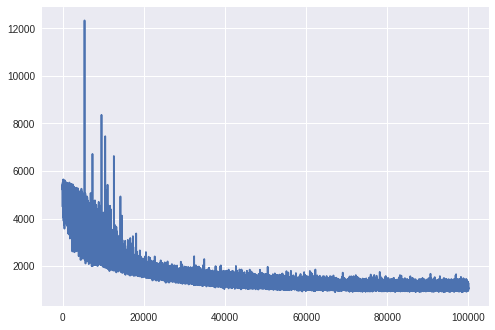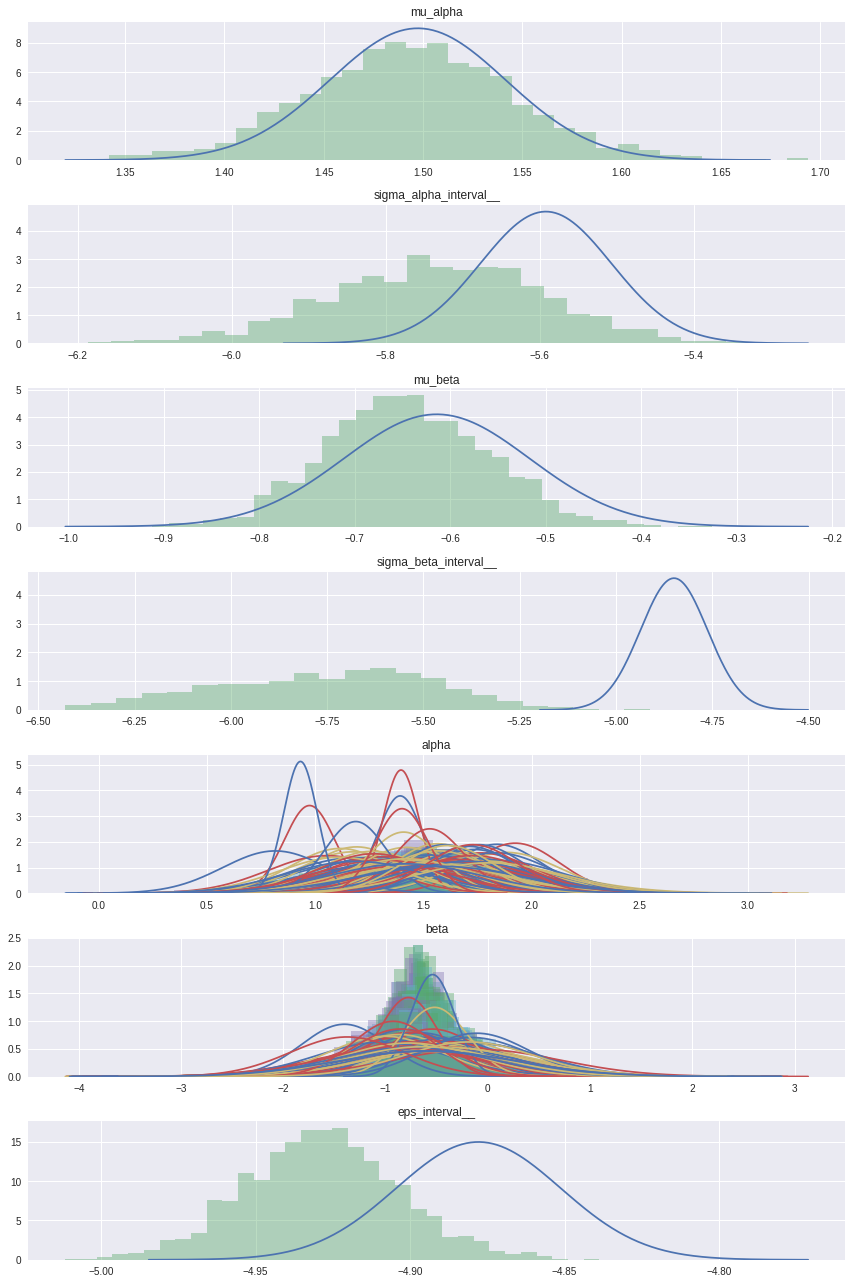GLM: Mini-batch ADVI on hierarchical regression model¶
Unlike Gaussian mixture models, (hierarchical) regression models have independent variables. These variables affect the likelihood function, but are not random variables. When using mini-batch, we should take care of that.
In [1]:
%matplotlib inline
%env THEANO_FLAGS=device=cpu, floatX=float32, warn_float64=ignore
import theano
import matplotlib.pyplot as plt
import numpy as np
import pymc3 as pm
import pandas as pd
data = pd.read_csv(pm.get_data('radon.csv'))
county_names = data.county.unique()
county_idx = data['county_code'].values
n_counties = len(data.county.unique())
total_size = len(data)
env: THEANO_FLAGS=device=cpu, floatX=float32, warn_float64=ignore
Here, ‘log_radon_t’ is a dependent variable, while ‘floor_t’ and ‘county_idx_t’ determine independent variable.
In [2]:
import theano.tensor as tt
log_radon_t = pm.Minibatch(data.log_radon.values, 100)
floor_t = pm.Minibatch(data.floor.values, 100)
county_idx_t = pm.Minibatch(data.county_code.values, 100)
In [3]:
with pm.Model() as hierarchical_model:
# Hyperpriors for group nodes
mu_a = pm.Normal('mu_alpha', mu=0., sd=100**2)
sigma_a = pm.Uniform('sigma_alpha', lower=0, upper=100)
mu_b = pm.Normal('mu_beta', mu=0., sd=100**2)
sigma_b = pm.Uniform('sigma_beta', lower=0, upper=100)
# Intercept for each county, distributed around group mean mu_a
# Above we just set mu and sd to a fixed value while here we
# plug in a common group distribution for all a and b (which are
# vectors of length n_counties).
a = pm.Normal('alpha', mu=mu_a, sd=sigma_a, shape=n_counties)
# Intercept for each county, distributed around group mean mu_a
b = pm.Normal('beta', mu=mu_b, sd=sigma_b, shape=n_counties)
# Model error
eps = pm.Uniform('eps', lower=0, upper=100)
# Model prediction of radon level
# a[county_idx] translates to a[0, 0, 0, 1, 1, ...],
# we thus link multiple household measures of a county
# to its coefficients.
radon_est = a[county_idx_t] + b[county_idx_t] * floor_t
# Data likelihood
radon_like = pm.Normal('radon_like', mu=radon_est, sd=eps, observed=log_radon_t, total_size=len(data))
Random variable ‘radon_like’, associated with ‘log_radon_t’, should be given to the function for ADVI to denote that as observations in the likelihood term.
On the other hand, ‘minibatches’ should include the three variables above.
Then, run ADVI with mini-batch.
In [4]:
with hierarchical_model:
approx = pm.fit(100000, callbacks=[pm.callbacks.CheckParametersConvergence(tolerance=1e-4)])
Average Loss = 1,123.9: 100%|██████████| 100000/100000 [00:29<00:00, 3391.31it/s]
Finished [100%]: Average Loss = 1,124
Check the trace of ELBO and compare the result with MCMC.
In [5]:
import matplotlib.pyplot as plt
import seaborn as sns
plt.plot(approx.hist)
Out[5]:
[<matplotlib.lines.Line2D at 0x7f39780ca588>]

In [6]:
# Inference button (TM)!
with pm.Model():
# Hyperpriors for group nodes
mu_a = pm.Normal('mu_alpha', mu=0., sd=100**2)
sigma_a = pm.Uniform('sigma_alpha', lower=0, upper=100)
mu_b = pm.Normal('mu_beta', mu=0., sd=100**2)
sigma_b = pm.Uniform('sigma_beta', lower=0, upper=100)
# Intercept for each county, distributed around group mean mu_a
# Above we just set mu and sd to a fixed value while here we
# plug in a common group distribution for all a and b (which are
# vectors of length n_counties).
a = pm.Normal('alpha', mu=mu_a, sd=sigma_a, shape=n_counties)
# Intercept for each county, distributed around group mean mu_a
b = pm.Normal('beta', mu=mu_b, sd=sigma_b, shape=n_counties)
# Model error
eps = pm.Uniform('eps', lower=0, upper=100)
# Model prediction of radon level
# a[county_idx] translates to a[0, 0, 0, 1, 1, ...],
# we thus link multiple household measures of a county
# to its coefficients.
radon_est = a[county_idx] + b[county_idx] * data.floor.values
# Data likelihood
radon_like = pm.Normal(
'radon_like', mu=radon_est, sd=eps, observed=data.log_radon.values)
#start = pm.find_MAP()
step = pm.NUTS(scaling=approx.cov.eval(), is_cov=True)
hierarchical_trace = pm.sample(2000, step, start=approx.sample()[0], progressbar=True)
100%|█████████▉| 2498/2500 [03:02<00:00, 16.93it/s]/home/ferres/dev/pymc3/pymc3/step_methods/hmc/nuts.py:456: UserWarning: Chain 0 contains 41 diverging samples after tuning. If increasing `target_accept` doesn't help try to reparameterize.
% (self._chain_id, n_diverging))
100%|██████████| 2500/2500 [03:02<00:00, 13.69it/s]
In [11]:
means = approx.gbij.rmap(approx.mean.eval())
sds = approx.gbij.rmap(approx.std.eval())
In [12]:
from scipy import stats
import seaborn as sns
varnames = means.keys()
fig, axs = plt.subplots(nrows=len(varnames), figsize=(12, 18))
for var, ax in zip(varnames, axs):
mu_arr = means[var]
sigma_arr = sds[var]
ax.set_title(var)
for i, (mu, sigma) in enumerate(zip(mu_arr.flatten(), sigma_arr.flatten())):
sd3 = (-4*sigma + mu, 4*sigma + mu)
x = np.linspace(sd3[0], sd3[1], 300)
y = stats.norm(mu, sigma).pdf(x)
ax.plot(x, y)
if hierarchical_trace[var].ndim > 1:
t = hierarchical_trace[var][i]
else:
t = hierarchical_trace[var]
sns.distplot(t, kde=False, norm_hist=True, ax=ax)
fig.tight_layout()
